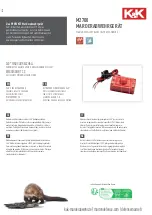
Planning
Mounting and Installation, Technical Description, T 811 065 en
35 / 41
5
Planning
Notice
Programming and planning of the unit is described in the current SecuriFire software documentation (document
in preparation).
5.1
Loop length
Information about the maximum number of loop lengths can be found in Section 1.2.2 SecuriLine eXtended.
Because of the large number of parameters, the loop length calculations are made with a PC program (Loop Length Calcula-
tor). For each loop the cable diameter and the number and participants per type are entered. The result is the maximum loop
length from interface side 1 (beginning) to the last detector on the loop, and the loop length from interface side 2 (end) to the
first detector.
5.2
Current consumption and bridging time
Notice
•
In the event of a power failure, the fire alarm control panel is powered by batteries. Depending on the con-
nected peripheral devices (EPI devices, detectors, sirens, etc.), it is important to ensure that the batteries
have sufficient capacity to operate the fire alarm control panel for the specified time (possibly according to a
standard or directive).
•
Moreover, the consumer current has to be dimensioned so that batteries which have become empty can be
charged to 80% of their capacity within 24 hours.
5.3
Typical power consumption values for B7-CPB11
The power consumption of the unit must also be taken into account when calculating the power requirement:
Type
Designation
Quiescent current
Alarm current
B7-CPB11
Main control unit, 1 loop
57 mA
1.7 A
5.4
Power requirement calculation
For the SecuriFire 500 power requirement calculation, a power calculation tool is available in which the battery types in use
and the necessary bridging time (according to local standards and directives) are entered.






































